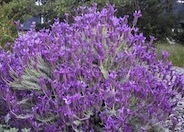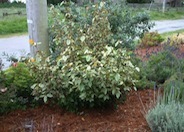
Common name:Spanish Lavender
Botanical name:Lavandula stoechas
This dense shrub grows 2-3 ft. tall with blue gray foliage and deep purple flowers that have large showy bracts near the top of the spikes. It is drought tolerant . - Cornflower Farms

Common name:Rosemary
Botanical name:Rosmarinus officinalis
Rosemary is hardy in full sun areas where winter temperatures do not drop below 10 degrees F. They can be grown in a clay pot with well-drained, porous soil in bright indoor light, and will also flourish on the backporch in spring, summer and fall.
Its beautiful, slowly trailing stems and shiny slender leaves are perfect for showing off the small light blue flowers that blossom in the summer.

Common name:Ruby Glow Manuka
Botanical name:Leptospermum scoparium 'Ruby Glow'
New Zealand Tea Tree has small, needle-like green leaves with showy, 1/2" rose-like flowers in winter and spring. These shrubs can be thinned to enhance their attractive branch structure and flaking bark. They need very little water once established. 'Ruby Glow' is compact, upright and grows 6-8' tall by 4-5' wide. It has dark foliage with deep red blooms; it works well as a red accent in the garden.

Common name:Fruitland Silverberry
Botanical name:Elaeagnus pungens 'Fruitlandii'
Evergreen shrub to about 15' overall. Large silvery leaves with rusty dots. Armed with spines. Good for hedge or dense barriers. Can be sheered; tolerates heat and wind.

Common name:Woolly Yarrow
Botanical name:Achillea tomentosa
Short stems of flat-topped golden flowers accent the deep green, wooly, fern-like leaves of the mat formed by this plant. It is a fine performer in rock gardens and at the front of herbaceous perennial borders.
Yarrows propagate easily from rooted stems or division, which should be performed in the early spring or fall. Following bloom, dead head the plant and divide the clumps when it appears crowded.

Common name:Bush Morning Glory
Botanical name:Convolvulus cneorum
This evergeen shrub grows 2-4 ft. high with silver foliage and white flowers from spring through fall. It prefers light soil, good drainage and full sun. - Cornflower Farms
If you have impermeable paving that you would like to make permeable, there are two main methods for doing so:
1. Break up hard paved surfaces to create spaces for water to seep through.
2. Remove and replace the surfaces with permeable paving.
Click in the green box for more information
Designer:
Photographer: GardenSoft
Maintain a two to four inch layer of mulch on the soil surface to reduce weeds, infiltrate rain water, and reduce compaction.
Be sure to fix all leaks promptly no matter how small they may seem.
Drip and other smart irrigation delivers water directly to roots, allowing no excess water for weeds.